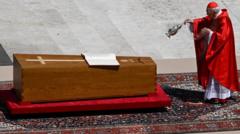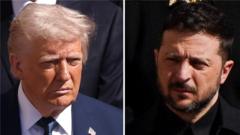With the passing of Pope Francis, the Catholic Church faces an intricate time of transition, laden with centuries-old practices and terminologies central to electing a new pope.
Pope Francis Remembered: Deciphering the Vatican's Transition Terminology

Pope Francis Remembered: Deciphering the Vatican's Transition Terminology
As the world mourns the loss of Pope Francis, understanding the papal transition process becomes essential.
The death of Pope Francis marks not only an end but a pivotal moment for the global Catholic community of over a billion members. As preparations for the transition unfold, it’s important to grasp the unique vocabulary that guides this solemn process.
One critical term is "conclave," which refers to the gathering of cardinals selected to elect the next pope. This meeting, isolated from the outside world, will commence next month and upholds strict confidentiality—no communication devices allowed, and voting is conducted by secret ballot until a two-thirds majority is achieved. The term "conclave" originates from the Latin word meaning “with key,” symbolizing the restricted accessibility of this influential gathering. The recent film "Conclave" has highlighted this intriguing aspect of papal selection, illustrating the drama involved in such decisions.
Another significant body involved in this process is the "College of Cardinals." This elite group consists of 252 cardinals—the senior clerics of the Catholic Church, charged with advising the pope and ultimately responsible for choosing his successor after his passing. The term "cardinal" itself derives from the Latin "cardinalis," meaning "serving as a hinge," reflecting their crucial role in Church operations. The current dean of the College, Giovanni Battista Re, will oversee the crucial meetings leading up to the conclave but, due to age, will not participate in the voting process, as only cardinals under the age of 80 are entitled to cast their votes.
As the faithful prepare to navigate this time of transition, understanding these terms and the structure guiding the election of a new leader provides insight into the traditions that shape this pivotal moment for the Catholic Church.
One critical term is "conclave," which refers to the gathering of cardinals selected to elect the next pope. This meeting, isolated from the outside world, will commence next month and upholds strict confidentiality—no communication devices allowed, and voting is conducted by secret ballot until a two-thirds majority is achieved. The term "conclave" originates from the Latin word meaning “with key,” symbolizing the restricted accessibility of this influential gathering. The recent film "Conclave" has highlighted this intriguing aspect of papal selection, illustrating the drama involved in such decisions.
Another significant body involved in this process is the "College of Cardinals." This elite group consists of 252 cardinals—the senior clerics of the Catholic Church, charged with advising the pope and ultimately responsible for choosing his successor after his passing. The term "cardinal" itself derives from the Latin "cardinalis," meaning "serving as a hinge," reflecting their crucial role in Church operations. The current dean of the College, Giovanni Battista Re, will oversee the crucial meetings leading up to the conclave but, due to age, will not participate in the voting process, as only cardinals under the age of 80 are entitled to cast their votes.
As the faithful prepare to navigate this time of transition, understanding these terms and the structure guiding the election of a new leader provides insight into the traditions that shape this pivotal moment for the Catholic Church.






















